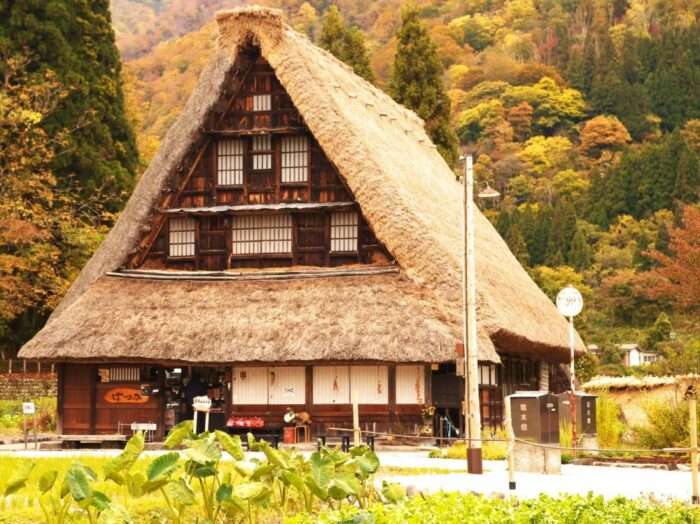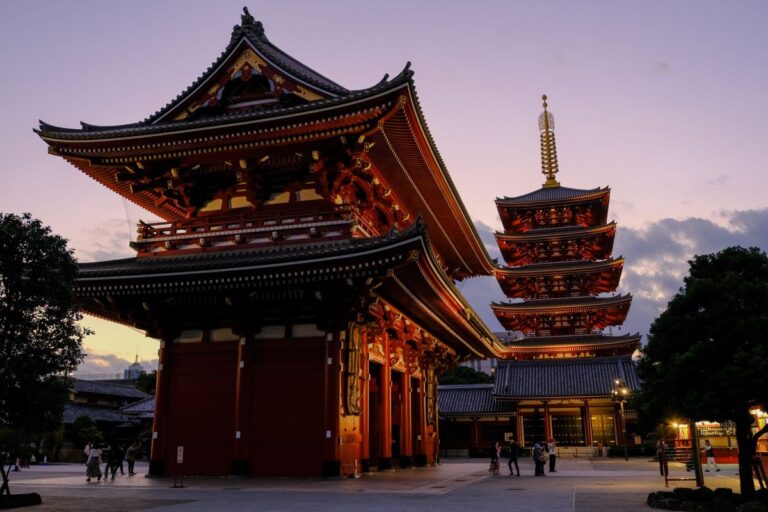In the mountainous regions of central Japan, amidst landscapes that blend raw natural beauty with the delicate artistry of human endeavor, a unique form of architecture has flourished. Known as the Gassho-style, this traditional Japanese architectural design can be seen in the quaint villages of Shirakawa-go and Gokayama.
The Gassho-style houses, with their distinctive steep thatched roofs, blend seamlessly into the surrounding landscapes, standing as a testament to Japan’s historical rural life and exceptional craftsmanship.
Origins of Gassho Style

Gassho-zukuri, which translates to “constructed like hands in prayer,” traces its roots back to the Edo period (1603–1868). The name “Gassho” is inspired by the resemblance of the steep roofs to the hands of Buddhist monks pressed together in prayer. This architectural style evolved organically, mirroring the geographical and climatic conditions of the region.
The regions where Gassho-style is predominantly found, including Shirakawa-go and Gokayama, are characterized by heavy snowfall in winter. Traditional flat-roofed structures would buckle under the weight of the snow, leading the ingenious locals to develop the steeply slanting roof design. This steep incline allows the heavy snow to slide off, thereby preserving the structural integrity of the house.

The Gassho style also resonates with the rural lifestyle of the region. The spacious interiors and the multi-storied design served the needs of extended family living, with the large attic space providing a perfect setting for sericulture, a primary source of income for the villagers.
Features of Gassho-Style Architecture

A Gassho-style house is an architectural marvel, where every element is infused with practical wisdom and a deep respect for nature. The design features of these houses offer a peek into the lifestyle and culture of the rural communities of Japan.
The Thatched Roofs: The defining feature of a Gassho-style house is its steep, thatched roof. Made from a thick layer of straw, the roofs are angled at approximately 60 degrees. The steepness of the roof prevents the build-up of snow in winter, while the thick layer of straw provides excellent insulation, keeping the house warm in winter and cool in summer.
Structure and Layout: Gassho-style houses are large wooden structures, often comprising of two to four levels. The lower levels serve as living spaces, with a central area designated for an ‘irori’ or a traditional Japanese hearth. The upper levels or the attic, accessible via steep staircases, were used for sericulture, allowing families to cultivate silkworms for silk production.
Materials: True to the principle of sustainability, Gassho-style houses are built using natural, locally available materials. The structural framework of the houses is made from timber, while the roofs are thatched with reeds or straw, harvested from the surrounding fields.
Irori (Hearth): The irori, a traditional Japanese sunken hearth, is an integral part of a Gassho-style house. Used for heating the house and cooking food, the irori is a symbol of the communal way of living, often serving as the gathering spot for the family.
Construction Techniques of Gassho-Style Houses

The Gassho-style is a testament to the exceptional craftsmanship of the bygone era, preserved and passed down through generations. The techniques involved in building these houses are as fascinating as the houses themselves.
No-Nails Construction: A standout aspect of the Gassho-style houses is their ‘no-nails’ construction. The timber framework is skillfully assembled using traditional joinery techniques, creating a sturdy structure that can withstand the occasional tremors common in Japan. The wooden joints, precisely cut and interlocked, provide the house with a certain flexibility, allowing it to sway slightly during earthquakes, thereby preventing major structural damage.
Thatching: The process of thatching the roof is a labor-intensive task, requiring skill and patience. The straw or reed is densely layered to create a thick cover, tightly secured to the wooden framework. This not only makes the roof weather-resistant but also provides natural insulation. Interestingly, the roofs are replaced every 20 to 30 years, a task that brings the whole community together, reflecting the spirit of ‘Yui,’ or mutual aid.
Yui – Community Involvement: In the past, constructing a Gassho-style house was a community event, known as ‘Yui.’ Given the scale of the task and the skills required, neighbors would come together to help one another in building houses. This community involvement was not only practical but also fostered a sense of unity and shared responsibility among the villagers.
Gassho-Style Today: Preservation and Modern Use

Today, Gassho-style houses stand as iconic symbols of Japan’s architectural heritage, offering a tangible link to the country’s past. With their cultural and historical significance, they have attracted the attention of conservationists and travelers alike.
In 1995, the historic villages of Shirakawa-go and Gokayama were declared UNESCO World Heritage Sites, emphasizing the global cultural value of these unique architectural structures. This recognition has resulted in increased efforts to preserve and restore the Gassho-style houses. Regular maintenance, including periodic roof replacement, is carried out to keep these houses in their original condition.
Simultaneously, to keep up with the changing times, these houses have also found new purposes. Several have been converted into guesthouses, known as ‘minshuku,’ providing visitors an immersive experience of traditional Japanese rural living. Others have been transformed into museums, showcasing artifacts and exhibitions related to the region’s rural lifestyle and sericulture practices.
However, Gassho-style is not merely relegated to the past. It continues to inspire modern architects, who have integrated the Gassho principles of harmony with nature and sustainability in contemporary designs.
Visiting Gassho-Style Villages

Gassho-style villages are a must-visit destination for any traveler exploring the heart of Japan. These well-preserved villages offer a unique opportunity to step back in time and witness firsthand the traditional Japanese rural lifestyle.
Shirakawa-go and Gokayama: These two villages are the most famous locations for experiencing Gassho-style architecture. Both are UNESCO World Heritage sites and are renowned for their picturesque landscapes dotted with Gassho-style houses. While Shirakawa-go is more popular and can be quite crowded, Gokayama is quieter and offers a more serene experience.
Tips for Visiting: When visiting these villages, it is essential to remember that many of these houses are not just historical structures but also private residences. It is important to respect the privacy of the residents and follow any guidelines or instructions provided. Most of the houses that are open to the public charge a small entry fee, which contributes to the maintenance of these historic structures.
Staying in a Minshuku: For a truly immersive experience, consider staying in a minshuku, or a traditional guesthouse. This will not only give you a chance to explore a Gassho-style house from the inside but also to experience the warm hospitality of the rural Japanese communities. Keep in mind that these are traditional homes, and the amenities are basic, so be prepared to sleep on futons and participate in communal dining.
Seasonal Variations: Each season offers a different perspective of the Gassho-style villages. The snow-covered roofs in winter create a magical, fairy-tale-like setting. In contrast, spring brings a burst of colors with blooming flowers, while autumn paints the landscape in warm hues.
The Sum Up

Gassho-style, with its unique design and construction, offers a glimpse into the resilience and ingenuity of Japan’s rural communities. These architectural masterpieces, born out of necessity and built with a profound respect for nature, continue to stand tall, preserving the cultural and historical legacy of rural Japan.
Whether you are an architecture enthusiast, a history buff, or a curious traveler, a visit to the Gassho-style villages is bound to be an unforgettable experience. As you explore these traditional houses, with their steep thatched roofs and spacious interiors, you will not only gain an appreciation for the architectural brilliance of Gassho-style but also for the timeless Japanese values of community, sustainability, and harmony with nature.
In today’s world, where the pace of change is rapid and the push for modernization relentless, the Gassho-style houses remind us of the importance of preserving our cultural heritage and living in balance with our environment.




